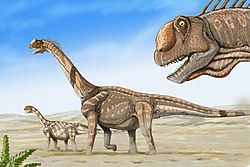Paleontology in Wyoming
Paleontology in Wyoming includes research into the prehistoric life of the U.S. state of Wyoming as well as investigations conducted by Wyomingite researchers and institutions into ancient life occurring elsewhere.
The
During the
During the early part of the
Prehistory
During the
During the
The

During the early part of the
History
Indigenous interpretations

Evidence for knowledge about fossils among the
Dinosaur skulls preserved in the Hell Creek or Lance Creek Formations may have inspired another fossil legend.
Other relevant possible influences include
Scientific research

One of the earliest fossil hunting excursions into Wyoming happened in 1870, when
Late in 1877, Marsh's

In September, they made another major discovery.
Another advancement in Wyoming paleontology occurred in 1932 when

In 1940 C. L. Gazin led an expedition into Wyoming on behalf of the Smithsonian Institution. Their biggest find was a nearly complete skeleton of Uintatherium. Fossils of Unitatherium are relatively common, but the specimen uncovered by Gazin's expedition was exceptionally complete and in high quality preservation. The only parts missing from the skeleton were the neck vertebrae, part of one forelimb, and a hindlimb.[18] The fossil was discovered on a steep hillside slope.[36] To remove the remains from their place of preservation, the team had to drive a truck up a dry creek bed and physically drag the remains out on canvas. The fossils were so numerous and massive that they filled four crates, each weighing 500 pounds. After being packaged into the crates the bones were shipped to Washington, D.C.[37]
In 1953, C. L. Gazin led another expedition into Wyoming for the Smithsonian. The crew's excavations in the Bison Basin uncovered the jaws and teeth of at least four species in two genera of
More recently, in 1977,
Protected areas
People
Walter W. Granger died in Lusk on September 6th, 1941 at age 68.
Natural history museums
- Paleon Museum, Glenrock, Wyoming
- Tate Geological Museum, Casper
- Draper Museum of Natural History, Buffalo Bill Historical Center, Cody
- Natural History Museum of Western Wyoming College, Rock Springs
- University of Wyoming Geological Museum, Laramie
- Wyoming Dinosaur Center, Thermopolis, Wyoming
See also
- Paleontology in Colorado
- Paleontology in Idaho
- Paleontology in Montana
- Paleontology in Nebraska
- Paleontology in South Dakota
- Paleontology in Utah
Footnotes
- ^ a b c Murray (1974); "Wyoming", page 293.
- ^ a b c d e Murray (1974); "Wyoming", page 294.
- ^ a b c d e f g h i Springer and Scotchmoor (2010); "Paleontology and geology".
- ^ a b c d Murray (1974); "Wyoming", page 296.
- ^ a b Lockley and Hunt (1999); "Figure 3.20", page 95.
- ^ a b Lockley and Hunt (1999); "The Northern Colorado Plateau Region of the Chinle", page 94.
- ^ Lockley and Hunt (1999); "The Moenkopi of the Early and Middle Triassic", page 72.
- ^ a b Lockley and Hunt (1999); "The Real Pterosaur Tracks Story", page 160.
- ^ Lockley and Hunt (1999); "The Real Pterosaur Tracks Story", pages 159-160.
- ^ Everhart (2005); "One Day in the Life of a Mosasaur", page 5.
- ^ Everhart (2005); "Enchodus and Cimolichthys", page 84.
- ^ Everhart (2005); "Enchodus and Cimolichthys", pages 84-85.
- ^ Everhart (2005); "Enchodus and Cimolichthys", page 86.
- ^ Everhart (2005); "Enchodus and Cimolichthys", page 87.
- ^ Everhart (2005); "Pliosaurs and Polycotylids", page 153.
- ^ Everhart (2005); "Turtles: Leatherback Giants", page 112.
- ^ Lockley and Hunt (1999); "Rare Tracks of the Laramie Formation", page 236.
- ^ a b c d Murray (1974); "Wyoming", page 297.
- ^ Mayor (2005); "Hopi and Pueblo Fossil Collectors", pages 157-158.
- ^ Mayor (2005); "Cheyenne Fossil Knowledge", pages 211-212.
- ^ a b Mayor (2005); "Cheyenne Fossil Knowledge", page 213.
- ^ a b Mayor (2005); "Cheyenne Fossil Knowledge", pages 212-213.
- ^ Everhart (2005); "Pteranodons: Rulers of the Air", page 195.
- ^ Foster (2007); "March 1877", pages 66-67.
- ^ Foster (2007); "Cope and Marsh: The Fuel for the Fire", page 68.
- ^ a b Foster (2007); "Como Bluff (1877-1889)", page 68.
- ^ Murray (1974); "Wyoming", page 295.
- ^ a b Foster (2007); "Como Bluff (1877-1889)", page 69.
- ^ Foster (2007); "Como Bluff (1877-1889)", pages 69-70.
- ^ Foster (2007); "Como Bluff (1877-1889)", page 70.
- ^ Foster (2007); "Como Bluff (1877-1889)", page 71.
- ^ Foster (2007); "Como Bluff (1877-1889)", page 72.
- ^ a b c Lockley and Hunt (1999); "Western Traces in the 'Age of Amphibians'", page 34.
- ^ Lockley and Hunt (1999); "Western Traces in the 'Age of Amphibians'", pages 34-35.
- ^ a b c Lockley and Hunt (1999); "Western Traces in the 'Age of Amphibians'", page 35.
- ^ Murray (1974); "Wyoming", pages 297-298.
- ^ Murray (1974); "Wyoming", page 298.
References
- Everhart, M. J. 2005. Oceans of Kansas - A Natural History of the Western Interior Sea. Indiana University Press, 320 pp.
- Foster, J. (2007). Jurassic West: The Dinosaurs of the Morrison Formation and Their World. Indiana University Press. 389pp. ISBN 978-0-253-34870-8.
- Lockley, Martin and Hunt, Adrian. Dinosaur Tracks of Western North America. Columbia University Press. 1999.
- Mayor, Adrienne. Fossil Legends of the First Americans. Princeton University Press. 2005. ISBN 0-691-11345-9.
- Murray, Marian (1974). Hunting for Fossils: A Guide to Finding and Collecting Fossils in All 50 States. Collier Books. p. 348. ISBN 9780020935506.
- Springer, Dale, Judy Scotchmoor. July 14, 2010. "Wyoming, US." The Paleontology Portal. Accessed September 21, 2012.
